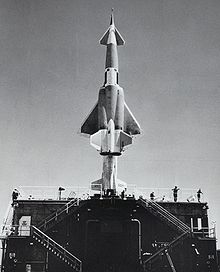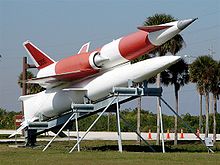- SM-64 Navaho
-
The North American SM-64 Navaho was a supersonic intercontinental cruise missile project built by North American Aviation. The program ran from 1946 to 1958 when it was cancelled in favor of intercontinental ballistic missiles. The missile is named after the Navajo Nation and is in keeping with North American Aviation's habit of naming projects with code names starting with the letters "NA".
Contents
Development
The Navaho program began as part of a series of guided missile research efforts started in 1946. Designated MX-770, the original intent of the program was the development of a winged V-2 missile that could deliver a nuclear (fission) warhead over a distance of 500 miles (800 km). This was more than double the range of the V-2 as well as having a larger payload. Design studies showed the promise of still greater ranges and by 1950 the vehicle had evolved from a 500-mile (800 km) ground launched winged V-2, to a 1,000-mile (1,600 km) range ramjet powered winged V-2, to a 1,500-mile (2,400 km) air-launched, ramjet-powered, winged V-2 (actually designated XSSM-A-2), to finally a 3,000-mile (4,800 km) plus rocket boosted ramjet powered cruise missile. The design evolution finally ended in July 1950 with the issuing by the Air Force of Weapon System 104-A. Under this new requirement the purpose of the program was the development of a 5,500-mile (8,900 km) range nuclear missile.[1]
Under the new requirements of WS-104A, the Navaho program was broken up into three guided missile efforts. The first of these missiles was the North American X-10, a flying subrange vehicle to prove the general aerodynamics, guidance, and control technologies for vehicles two and three. The X-10 was essentially an unmanned high performance jet, powered by two afterburning J-40 turbojets and equipped with retractable landing gear for take off and landing. It was capable of speeds up to Mach 2 and could fly almost 500 miles (800 km). Its success at Edwards AFB and then at Cape Canaveral set the stage for the development of the second vehicle: XSSM-A-4, Navaho II, or G-26.
Step two, the G-26, was a nearly full-size Navaho nuclear vehicle. Launched vertically by a liquid-fuel rocket booster, the G-26 would rocket upward until it had reached a speed of approximately Mach 3 and an altitude of 50,000 ft (15,000 m). At this point the booster would be expended and the vehicle's ramjets ignited to power the vehicle to its target. The G-26 made a total of 10 launches from Launch Complex 9 (LC-9) at Cape Canaveral Air Force Station (CCAFS) between 1956 and 1957. Launch Complex 10 (LC-10) was also assigned to the Navaho program, but no G-26's were ever launched from it (it was only used for ground tests of the planned portable launcher).
The final operational version, the G-38 or XSM-64A, was the same basic design as the G-26 only larger. It incorporated numerous new technologies: Titanium, gimballed rocket engines, Kerosene/Lox fuel combination, full solid-state, etc. None were ever flown, the program being cancelled before the first example was completed. The advanced rocket booster technology went on to be used in other missiles including the Atlas intercontinental ballistic missile and the inertial guidance system was later used as the guidance system on the first U.S. nuclear powered submarines.
Development of the first stage rocket engine for the Navaho began with two refurbished V-2 engines in 1947. That same year, the phase II engine was designed, the XLR-41-NA-1, a simplified version of the V-2 engine made from American parts. The phase III engine, XLR-43-NA-1 (also called 75K), adopted a cylindrical combustion chamber with the experimental German impinging-stream injector plate. Engineers at North American were able to solve the combustion stability problem, which had prevented it being used in the V-2, and the engine was successfully tested at full power in 1951. The Phase IV engine, XLR-43-NA-3 (120K), replaced the poorly cooled heavy German engine wall with a brazed tubular ("spaghetti") construction, which was becoming the new standard method for regenerative cooling in American engines. A dual-engine version of this, XLR-71-NA-1 (240K), was used in the G-26 Navaho. With improved cooling, a more powerful kerosene-burning version was developed for the triple-engine XLR-83-NA-1 (405K), used in the G-38 Navaho. With all the elements of a modern engine (except a bell-shaped nozzle), this led to designs for the Atlas, Thor and Titan engines.
The first launch attempt, in November 1956, failed after 26 seconds of flight. Ten failed launches followed, before another got off successfully, on 22 March 1957, for 4 minutes, 39 seconds of flight. An April 25 attempt exploded seconds after liftoff, while a 26 June flight lasted only 4 minutes, 29 seconds. [2]
Officially, the program was canceled on July 13, 1957 after the first four launches ended in failure. In reality the program was obsolete by mid-1957 as the first Atlas ICBM began flight tests in June and the Jupiter and Thor IRBMs were showing great promise. These ballistic missiles however would not have been possible without the liquid fuel rocket engine developments accomplished in the Navaho program. The launch of the Soviet Satellite Sputnik in October 1957 only finished Navaho as the Air Force shifted its research money into ICBMs. But the technologies developed for the Navaho were reused in 1957 for the development of the AGM-28 Hound Dog, a nuclear cruise missile which entered in production in 1959.
The Soviet Union had been working on parallel projects, The Myasishchev "Buran" and Lavochkin "Burya" and a little later, the Tupolev Tu-123. The first two types were also large rocket-boosted ramjets while the third was a turbojet-powered machine. With the cancellation of the Navaho and the promise of ICBMs in the strategic missile role, the first two were canceled as well, though the Lavochkin project, which had some successful test flights, was carried on for R&D purposes and the Tupolev was reworked as a big, fast reconnaissance drone.
Operators
 United States: The United States Air Force canceled the program before accepting the Navaho into service.
United States: The United States Air Force canceled the program before accepting the Navaho into service.
Survivors
The only Navaho missile in existence is currently displayed outside the south entrance gate of the Cape Canaveral Air Force Station, Florida.
Specifications
General characteristics
- Length: 67 ft 11 in (20.7 m)
- Wingspan: 28 ft 7 in (8.71 m)
- Height: ()
- Loaded weight: 64,850 lb (29,420 kg)
- Powerplant:
- 2 × XRJ47-W-5 ramjets, 15,000 lbf (67 kN) each
- 2 × XLR83-NA-1 rocket boosters, 200,000 lbf (890 kN) each
Performance
- Maximum speed: Mach 3 (2,000 kn, 3,700 km/h)
- Range: 3,500 nmi, (6,500 km)
- Service ceiling: 77,000 ft (23,000 m)
- Thrust/weight (jet): 0.46:1
Armament
- 1 × W41 nuclear warhead
See also
- Aircraft of comparable role, configuration and era
- Related lists
References
- ^ *Gibson, James N. "The Navaho Missile Project/ The Story of the Know-How missile of American Rocketry," Altglen, PA, Schiffer Publishing, 1996, ISBN 0-7643-0048-2.
- ^ Werrell, Kenneth P., "The Evolution of the Cruise Missile", Air University, Maxwell Air Force Base, Montgomery, Alabama, first printing 1995, second printing 1998, Library of Congress card number 85-8131, ISBN 358-174-0973, page 98.
External links
- The Evolution of the Cruise Missile by Werrell, Kenneth P.
- Directory of U.S. Military Rockets and Missiles: North American SM-64 Navaho, by Andreas Parsch
- http://www.astronautix.com/lvs/navhog26.htm
- http://www.fas.org/nuke/guide/usa/icbm/n19980710_981014.html
1955-1962 United States Air Force rocket and missile designationsAir-to-air missiles Other missiles - See also:
- Alpha Draco
- Bold Orion
- High Virgo
- Pye Wacket
- Sky Scorcher
- United States tri-service missile and drone designations post-1962
USAAS/USAAC/USAAF/USAF bomber designations 1924–1962 Bomber XB-1 · B-2 · B-3 · B-4 · B-5 · B-6 · Y1B-7 · XB-8 · YB-9 · B-10 · YB-11 · B-12 · XB-13 · XB-14 · XB-15 · XB-16 · B-17 · B-18 · XB-19 · Y1B-20 · XB-21 · XB-22 · B-23 · B-24 · B-25 · B-26 · XB-27 · XB-28 · B-29 · XB-30 · XB-31 · B-32 · XB-33 · B-34 · YB-35 · B-36 · B-37 · XB-38 · XB-39 · YB-40 · XB-41 · XB-42 · XB-43 · XB-44 · B-45 · XB-46 · B-47 · XB-48 · YB-49 · B-50 · XB-51 · B-52 · XB-53 · B-54 · XB-55 · XB-56 · B-57 · B-58 · XB-59 · YB-60 · B-61 · B-62 · B-63 · B-64 · B-65 · B-66 · B-67 · XB-68/SM-68 · RB-69 · XB-70 · SR-71
Light bomber Heavy bomber XHB-1 · XHB-2 · XHB-3
Long-range bomber 1947-1951 United States Air Force rocket and missile designationsAir-to-air missiles AAM-A-1 • AAM-A-2
Air-to-surface missiles ASM-A-1 • ASM-A-2
Surface-to-air missiles SAM-A-1
Surface-to-surface missiles Launch test vehicles LTV-A-1
Propulsion test vehicles Rocket test vehicles Types of missile By platform - Air-to-air missile (AAM)
- Air-to-surface missile (ASM)
- Surface-to-air missile (SAM)
- Surface-to-surface missile (SSM)
- Ballistic missile
- Intercontinental ballistic missile (ICBM)
- Submarine-launched ballistic missile (SLBM)
- Anti-ballistic missile (ABM)
- Intermediate-range ballistic missile (IRBM)
- Cruise missile
- Anti-ship missile (AShM)
- Anti-submarine missile
- Anti-tank missile (ATGM)
- Anti-satellite weapon (ASAT)
- Air-launched ballistic missile
- Anti-ship ballistic missile (ASBM)
By guidance Lists - List of missiles
- List of missiles by country
- List of military rockets
Categories:- Cold War cruise missiles
- Cold War nuclear missiles
- Nuclear cruise missiles of the United States
- Nuclear cruise missiles of the United States Air Force
- Ramjet-powered aircraft
Wikimedia Foundation. 2010.


